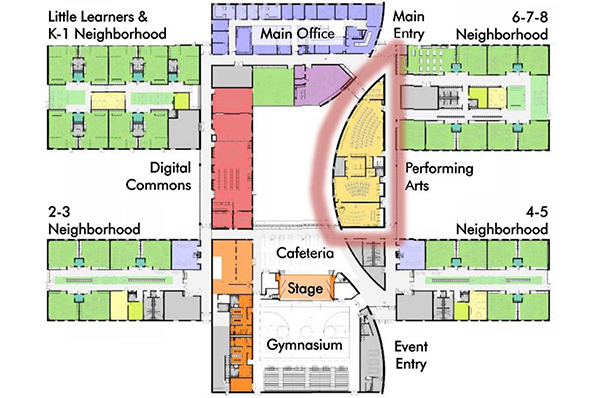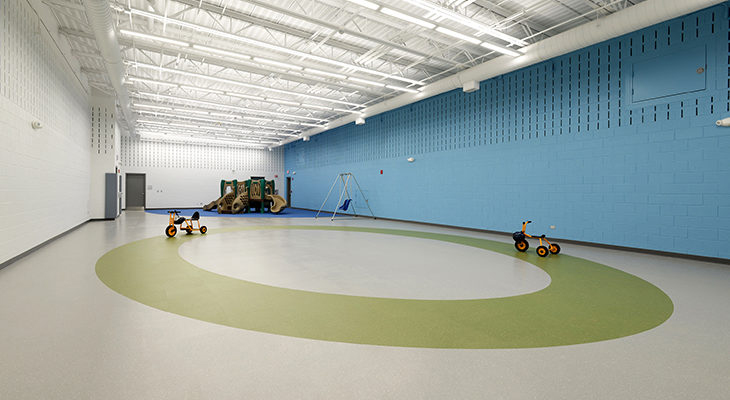
From ventilation and projectile defense to water supply and signage: a closer look at the complex code requirements for tornado shelters at Illinois schools
In June 2021, an EF3 tornado swept through several suburbs located 20 miles southwest of Chicago. It struck residential areas just after 11 pm . . . only minutes after wireless emergency alerts (WEAs) began blaring from enabled mobile phones. The tornado wreaked the most damage just a few short miles from my own home. After seeing the devastation around my kids’ elementary school, I wanted to revisit my experiences designing tornado shelters for schools and give school operators a few tips for making sure their shelters are as safe as possible.
Weather-related data has been collected in the US for over a century, but detailed information about tornados did not start getting recorded until 1950. Although tornados have historically targeted the dubious “Tornado Alley” in south-central US, they are no strangers to the Midwest. When I checked NOAA’s National Weather Service Storm Prediction Center for the three states in which Legat Architects operates studios, I learned that both Illinois and Iowa have had more than 2,500 tornadoes each since 1950, while Ohio has topped 1,000.
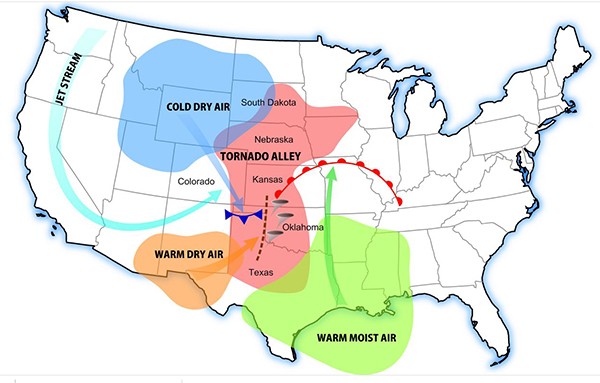
State Climatologist Office for Illinois statistics reveal an increase in annual tornadoes within the state since 1950. This could be attributable to a combination of several factors: better record keeping (e.g., the increased use of Doppler radar starting in the mid-1990s), greater population (more likely to report sightings), and climate change. A growing body of research suggests that climate change may be shifting Tornado Alley eastward toward the Midwestern states.
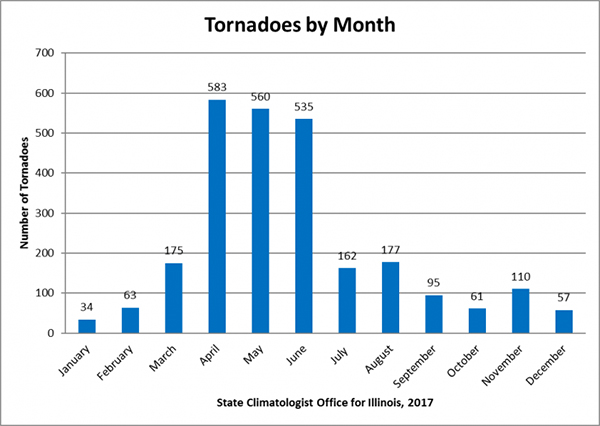
from https://stateclimatologist.web.illinois.edu/tornado-plots-for-illinois/
Tornados can strike at any time of the year and any time of the day. However, there are times when they are more likely to occur. In Illinois, tornado activity typically peaks during late afternoon and early evening hours in April, May, and June. Thus, many tornados strike after the school day ends. This suggests that school tornado shelters should be built not just for occupants during the school day, but also for those using the building after hours.
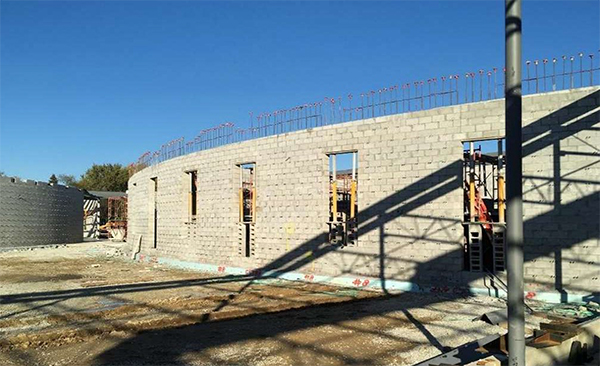
Illinois Tornado Shelter Code Overview
Since most schools that I’ve designed are in Illinois, I’ve spent many hours reviewing state requirements for tornado shelters.
The 2015 International Building Code (IBC 2015), which is applicable to schools in Illinois (except for those in Chicago), requires that storm shelters be compliant with the International Code Council (ICC)/National Storm Shelter Association (NSSA) Standard for the Design and Construction of Storm Shelters (ICC 500). It applies to Group E occupancies (i.e., a building in which six or more people gather at one time for educational purposes through 12th grade) which house more than 50 people. The shelter must be designed to hold the entire population of the school while resisting a windspeed of 250 miles per hour and wind-borne debris impacts of 100 miles per hour.
Part 180, Health/Life Safety Code for Public Schools, applies to school buildings in Illinois and mandated compliance with ICC 500 beginning January 2015. As with IBC, compliance for new school construction is required, but it takes one step further by also applying it to expansions. If a school is building an addition that increases the building by more than 50% of the original area, then the school must have a storm shelter that protects the entire population. This stipulation stretches over a two-year period—a school cannot evade a shelter by building an addition that increases the original area by 25% one year, then build a second addition that increases it by another 25% the next year.
What Causes the Most Damage?
Many people are surprised to learn that most tornado-related damage isn’t caused by windspeed or the twister itself, but rather by projectiles. Accordingly, ICC 500 requires that storm shelter windows, walls, doors, etc. be designed to withstand projectiles moving at 100 miles per hour (vertical impact resistance) while horizontal surfaces, like roofs, withstand 67 mph projectiles.
Where entrances or other openings are not able to meet these requirements, ICC 500 requires debris to impact at least two surfaces before arriving at the protected occupant area. Sometimes, when designing bathrooms or locker rooms, we create a “mazed” entrance to provide visual screening for privacy. This thought process proves the best entrance to a tornado shelter or any other severe weather shelter area whether ICC 500 compliant or not.
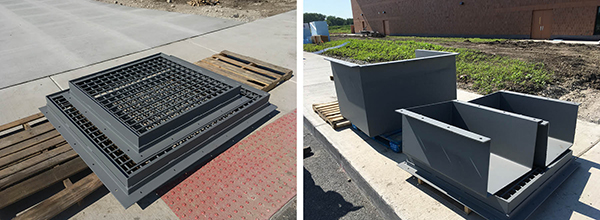
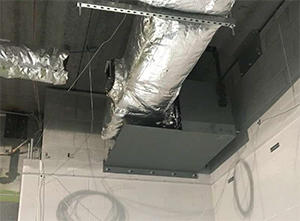
Projectile defense is also critical when it comes to penetrations for mechanical, plumbing, and sprinkler systems. For instance, bent steel plates arranged in a similar, maze-like configuration, prevent projectiles from getting through wall penetrations. Welded wire mesh grilles placed over roof penetrations help keep flying debris from coming in through the ceiling.
Occupancy Requirements
The ICC 500 requires storm shelters be designed to maintain occupancy for two hours allocating five square feet for each person, ten square feet for those in wheelchairs, and 30 square feet for those who are bed-ridden. The code also says the shelter must accommodate every occupant of the school’s typical (daytime) capacity. But what if there is an atypical event, like a kindergarten spring play, for example, with parents and grandparents in the building? It may be cost prohibitive to design a storm shelter for every occurrence, but being realistic during planning about the appropriate size of a tornado shelter is an important discussion to have with school administrators.
When Codes Are Vague, Aim for the Safest Solution
Sometimes, code-related literature is a bit on the ambiguous side. For instance, ICC 500 requires storm shelters be surrounded by a two-hour “fire barrier” to prevent the spread of fire into the shelter. This does not mean the storm shelter has to be structurally separated from its adjoining school building as with a “fire wall.” However, the storm shelter needs to be designed to meet the requirements of ICC 500 whether or not the adjoining building has collapsed during a storm event. This implies the shelter must be structurally separate.
My advice for this type of uncertainty is to always err on the side of the safest interpretation. Therefore, in the example above, designing the perimeter of the storm shelter as fire walls more closely follows the intent of ICC 500. This means creating parallel structures where the storm shelter and building abutting it are not structurally reliant on each other. Another approach is to incorporate “slip connections” (i.e., steel angles attached to the storm shelter that allow the bar joists of the adjacent building to pull away and collapse while the shelter stays intact).
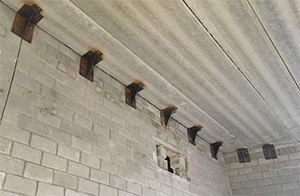
Case Study 1: Laraway Elementary School
When designing the new Laraway School (Joliet, Illinois), we spent a great deal of time considering the most appropriate location for a storm shelter. Using “self-contained” classroom wings would be convenient, but the budget couldn’t support making exterior windows projectile resistant and we weren’t willing to lose the glass openings between classrooms and corridors. A similar conundrum presented itself when we considered the school library. The gymnasium was also an obvious choice, but its large size made designing an ICC 500 compliant roof structure cost prohibitive.

In the end, the performing arts area (including band, music, and orchestra classrooms) proved the best place for a storm shelter. One wall was already planned to be a two-hour fire wall and we wanted these rooms to be acoustically isolated. It was logical to go one step further and make this cluster of rooms the storm shelter. The school district, however, did not want these classrooms to lack the natural light that permeates other student-occupied spaces. Windows meeting ICC 500 projectile impact requirements were installed in each room.
The size and shape of the performing arts area offered another benefit: although we were only required to accommodate 640 people, the Laraway storm shelter can accommodate 816. Therefore, if the total building occupancy rises during school events, the storm shelter can safely house an increased population.
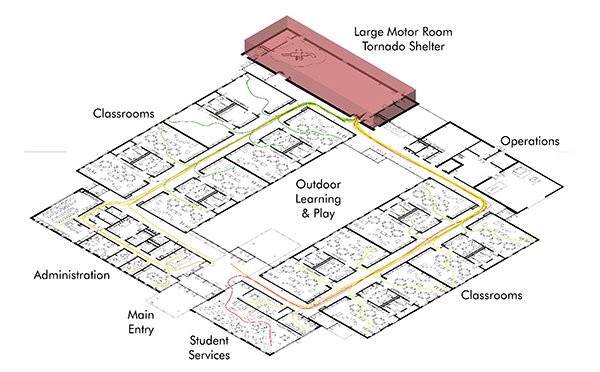
Case Study 2: Jefferson Early Childhood Center
For the new Jefferson Early Childhood Center (Wheaton, Illinois), we approached the tornado shelter using a thought process similar to that at Laraway. In this case, a large motor skills room doubles as a storm shelter that can hold nearly 500 people (the school’s student capacity is 385).
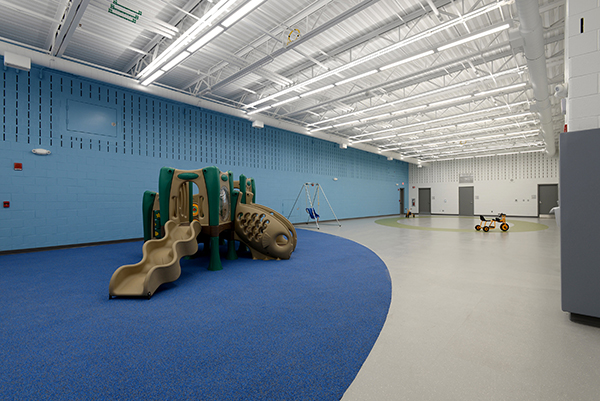
The space is well-suited for a shelter. It did not require windows or other openings and its structure was easily separated from the adjacent building. Also, the day-to-day requirements for HVAC systems and plumbing meant mechanical equipment and toilet rooms could be housed within the storm shelter, thereby eliminating the need for duct and pipe penetrations through shelter walls.
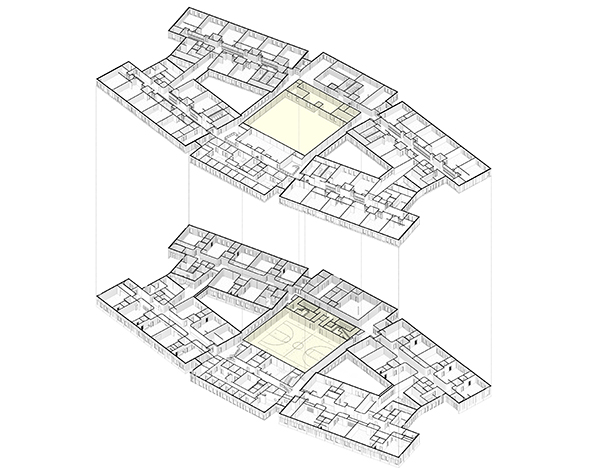
Case Study 3: AERO Therapeutic Center
The two-story AERO Therapeutic Center (Burbank, Illinois) now in the design phase is intended to house 550 students with special needs plus 375 staff. The unique needs of the student population demand careful consideration of the storm shelter design.
The gymnasium was selected for the storm shelter because its first-floor location is centrally positioned between four first-floor and four second-floor classroom wings to reduce travel distances. Two of the building’s six stairs and a second-floor exercise room are also located within the shelter. Although the gym can more than accommodate the building’s population, the stairs and exercise room offer opportunities for moving potentially fragile occupants to safety more quickly.
Despite being surrounded by its host building, the storm shelter enclosure and all openings and penetrations are being designed to be ICC 500 compliant under the assumption the shelter occupants are to be appropriately protected even if the surrounding building is compromised by a severe weather event.
Power, Ventilation, and Fresh Water
To adequately support the storm shelter population for two hours, ICC 500 requires the facility to provide emergency power, ventilation with fresh air, and plumbing.
A generator may seem to be an obvious choice to provide emergency power. However, providing power for two hours during a severe weather event will require the generator to be protected and possibly located inside the shelter. Another consideration is the fuel source. Natural gas or other fuel lines may be interrupted by the event and having gasoline or propane within the shelter is not recommended—not only are these fuels flammable, but the fumes may be noxious. Both Laraway and Jefferson schools opted to use lighting where emergency fixtures are equipped with battery backup.
For fresh air, naturally ventilating the storm shelter in accordance with ICC 500 is a better option since mechanical equipment could be adversely affected by the severe weather event. Exterior louvers should be appropriately rated and separated from the interior of the storm shelter by manually operated storm shutters or doors.
As with emergency power, a source for pressurized, potable water for plumbing fixtures needs to be carefully considered. At Laraway School, a dedicated, underground water service was brought directly into the storm shelter. Although authorities approved this solution, one question that arose was, “What happens if the municipal water service is disrupted?”
At Jefferson Center, we located a water storage tank with a pressure bladder inside the storm shelter between the building’s water service loop and the shelter’s plumbing fixtures. In this arrangement, potable water is constantly circulating through the tank as opposed to using a ceiling-suspended storage tank, which may be filled and not regularly flushed.

Signs of Shelter
Signage is another important consideration. School building occupants need to know the storm shelter exists and how to find it. ICC 500 requires signs that identify the location and all rooms of the storm shelter, as well as critical design information. The signs need to be located outside and inside the storm shelter entrance. I also recommended directional signage be located throughout the school to guide occupants to the shelter.
Storm Shelter Maintenance and Operations Tips
As with any building, storm shelters require preventative maintenance. School administrators should be taking steps to ensure storm shelters are ready to perform and their students and staff know what to expect. Following are a few actions school personnel should be considering on a regular basis:
- Identify a shelter manager, someone who knows what to do (e.g., organize occupants, secure shelter doors, open ventilation doors and louvres) during an emergency.
- Schedule severe weather drills just like fire drills so building occupants understand how to get to the shelter as quick as possible and know what is expected once inside.
- Keeping children (and adults) still for any length of time is a challenge. Consider storing activities, snacks, blankets, spare clothes, etc. in the storm shelter.
- Inspect shelter doors, shutters, and windows regularly. A projectile-resistant door is heavier than a typical fire door. Hinges may loosen over time causing the doors to rub the frame and making the already heavy door even more difficult to operate. Make sure door latches engage the frame.
- Verify wall penetrations are appropriately sealed and the sealant has not failed. Many sealants are designed to last 10 or more years, but certain conditions may cause sealant to fail sooner.
- Verify batteries for emergency lights are appropriately charged and functioning properly.
- Exercise emergency power generators weekly. Larger generators may have programmable control sequences. Verify their ability to run for a set time on a regular basis.
- Potable water storage tanks should be flushed once a week at a minimum to reduce the opportunities for bacteria growth.
- Exercise isolation valves on service piping, like natural gas and sprinkler piping, entering the storm shelter so corrosion does not prevent valves from closing fully.
- Inspect ventilation louvers to verify they’re not obstructed with snow, birds’ nests or other debris.
- Monitor operational status of mechanical ventilation components. Make sure switches and louver actuators are working.
Safety First
As educational planners, we often pride ourselves on our ability to design flexible, sustainable, state-of-the-art schools that enhance student performance. It’s equally important for the occupants to feel safe.
The ICC 500 gives building designers the technical know-how for designing storm shelters, but doing it well requires more input. All project stakeholders are responsible for the safety of the building’s occupants. Although the probability of a tornado striking any given school is low, nature continues to prove it is possible. What we can do is work together to prepare for the worst-case scenario by designing, building, and maintaining code-compliant storm shelters.
Contact us to learn more about storm shelter design or comment below to share your thoughts on this post.
